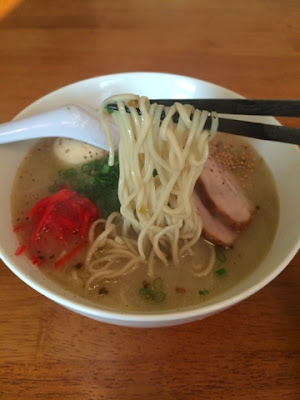Topped with pork belly chashu, plenty of green onion, some onion lard, 6:30 sec egg, some benishoga (red ginger), and sesame and pepper of all things! Just like the way those last two looked.
The homemade noodles this go around contain egg white as part of the liquid content. Some recipes suggested this improved their chew, but I don't think they're necessary for this thinner style. Maybe would work with a Sapporo noodle, one with more robust chew. Here, I'm going for a bite, something that sort of breaks against the teeth. That requires lower water content, less protein perhaps too.
Looking back, this could have definitely used more aroma oil. Maybe a full tablespoon next time.
I'm also noticing that the soup probably could have gone longer on the fire, or reduced more. You can see it has some translucency, which keeps bothering me. It went for 12 hours after bone blanch, and, although jelly in the fridge, was surprisingly loose. This is a really light soup for a Tonkotsu. Which isn't bad... Actually it's kind of nice, but the consistency isn't as rich as I was hoping. Still, the pork flavor is solid, and balanced well. And it's got good color. My tongue feels coated in collagen.
I still have a lot of practice to do on this style of soup, but things look promising. I might amp up the salinity of the tare, however.
Speaking of which...
Stupid easy shoyu tare:
50 ml sake
50 ml mirin
2 tbs brown sugar
400 ml soy sauce (of choosing)
150 ml dashi
Combine sake and mirin in a sauce pot, being to a boil to remove most of the alcohol. Add sugar, dissolve. Cut heat, add soy sauce, turn heat on and to medium, bring liquid to 178 degrees f. Add dashi. Chill. Done.
Perhaps a tablespoon of salt would help this out... It's pretty loose and not as salty as I'd like.
Now I have leftovers... What to do??








